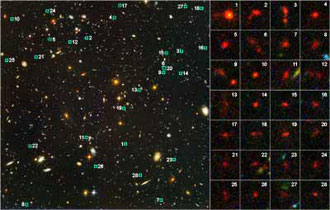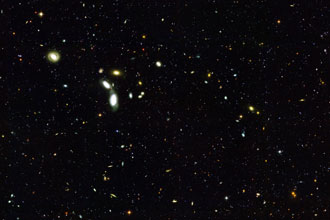 |  |  |  |  | Hubble Finds Hundreds of Young Galaxies in Early Universe
|
04.xx.06
|
 Astronomers analyzing two of the deepest views of the cosmos made with NASA's Hubble Space Telescope have uncovered a goldmine of galaxies, more than 500 that existed less than a billion years after the Big Bang.
Astronomers analyzing two of the deepest views of the cosmos made with NASA's Hubble Space Telescope have uncovered a goldmine of galaxies, more than 500 that existed less than a billion years after the Big Bang.
These galaxies thrived when the cosmos was less than 7 percent of its present age of 13.7 billion years. This sample represents the most comprehensive compilation of galaxies in the early universe, researchers said.
Image above: This Hubble image shows 28 of the more than
500 young galaxies found in the Hubble Ultra Deep Field,
with boxes corresponding to close-up views at right. The galaxies appear red because of their tremendous distance
from Earth. Photo Credit: NASA
+ Browse Resolution |
+ Full Resolution |
+ More on the Hubble Ultra Deep Field
The discovery is scientifically invaluable for understanding the origin of galaxies. Just a decade ago early galaxy formation was largely uncharted territory. Astronomers had not seen even one galaxy that existed when the universe was a billion years old, so finding 500 in a Hubble survey is a significant leap forward for cosmologists.
The galaxies unveiled by Hubble are smaller than today's giant galaxies and very bluish in color, indicating they are ablaze with star birth. The images appear red because of the galaxies’ tremendous distance from Earth. The blue light from their young stars took nearly 13 billion years to arrive at Earth. During the journey, the blue light was shifted to red light due to the expansion of space.
“Finding so many of these dwarf galaxies, but so few bright ones, is evidence for galaxies building up from small pieces -- merging together as predicted by the hierarchical theory of galaxy formation," said astronomer Rychard Bouwens of the University of California, Santa Cruz, who led the Hubble study.
Until recently, astronomers did not have the technology to hunt for faraway galaxies in large numbers. The installation of the Advanced Camera for Surveys aboard the Hubble Space Telescope in 2002 allows astronomers to probe some of the deepest recesses of our universe. Bouwens and his team spied these galaxies in an analysis of the Hubble Ultra Deep Field, completed in 2004, and the Great Observatories Origins Deep Survey, made in 2003. The results have been submitted for publication in the Astrophysical Journal.
The findings also show that early dwarf galaxies were producing stars at a furious rate, about ten times faster than is happening now in nearby galaxies. Astronomers have long debated whether the hottest stars in early star-forming galaxies, such as those in this study, may have provided enough radiation to reheat the cold hydrogen gas that existed between galaxies in the early universe. The gas had been cooling since the Big Bang.
 Image right: Astronomers also used the Great Observatories Origins Deep Survey, completed in 2003, in their search for early galaxies. The survey used images from Hubble and the Chandra X-Ray Telescope. Photo Credit: NASA
Image right: Astronomers also used the Great Observatories Origins Deep Survey, completed in 2003, in their search for early galaxies. The survey used images from Hubble and the Chandra X-Ray Telescope. Photo Credit: NASA
+ Full Size
"Seeing all of these starburst galaxies provides evidence that there were enough galaxies one billion years after the Big Bang to finish reheating the universe," explained team member Garth Illingworth of the University of California, Santa Cruz. "It highlights a period of fundamental change in the universe, and we are seeing the galaxy population that brought about that change."
In terms of human lifetimes, cosmic events happen very slowly. The evolution of galaxies and stars, for example, occurs over billions of years. Astronomers rarely witness dramatic, relatively brief transitions that changed the universe. One such event was the universe's "reheating." The reheating, driven by the galaxies' ultraviolet starlight, transformed the gas between galaxies from a cold, dark hydrogen soup to a hot, transparent plasma over only a few hundred million years. With Hubble's help, astronomers are beginning to see the kinds of galaxies that generated the reheating.
|
|  |
